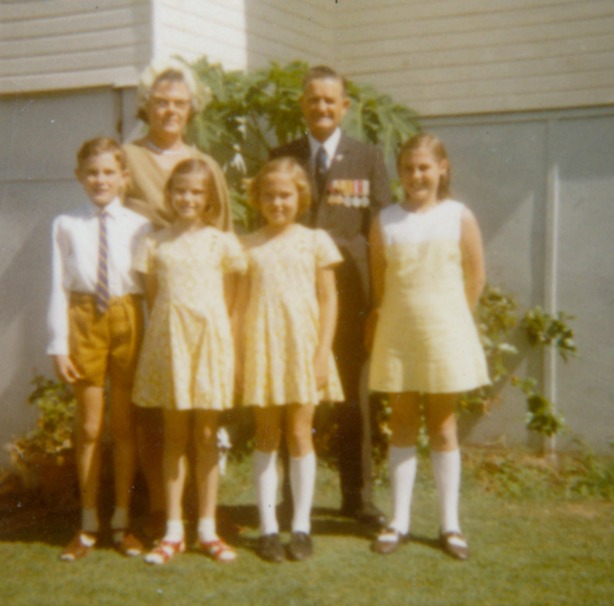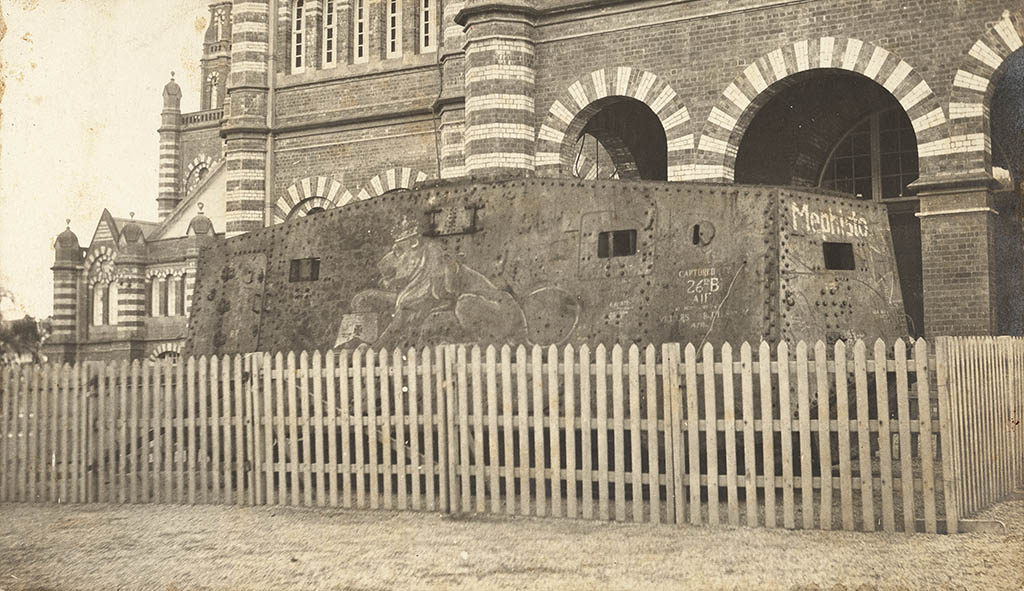I grew up in Windsor in the 1960s. When I was about 9 or 10, it was not unusual for our mums to give us 2/- (20c) and tell us to go out for the day. There was nothing my friends and I liked more on a weekend than to catch the tram to the Centenary Pool, then follow it up with a visit to the Old Museum. There were usually 5 or 6 of us (no adults) and we would spend hours exploring the nooks and crannies of the old Gothic building in Gregory Terrace or playing on the Mephisto Tank that stood like a guardian at the main entrance. One day we decided to play a game of hide and seek on the first floor where all the insect cabinets were. I always found this the most interesting part of the Museum, because you could look down on the T Rex skeleton or Bert Hinkler’s Avian from above. Anyway, we were playing hide and seek when my friend said he spotted one of the girls in our group hiding on the stairs leading up to the next floor. However, when we called out to her, she took off up the stairs. To our surprise, when we turned around our friend was behind us and she said that she had spotted the other girl too. So we went to see where the girl on the stairs had gone, but when we got there we found that the stair led to a door that was firmly locked. I had not thought about that much in the past 50 years until recently when I was talking to Alannah Ruth, the present curator of the Old Museum Building, who told me an eerily familiar story about the Ghost of the young girl who lives on the stair!
Tag: Mephisto
My earliest childhood memories are so very special to me and all my siblings. We grew up in the early 1950s around the Lota–Wynnum area. My dad built our house at Lota when there were only a very few people in the area. We first lived at Allister Street Lota in the small two-bedroom house that is still standing to this day. Each fortnight my dad would add a little more to the house, as money was hard to come by and building materials were very dear.
We were a poor family, but very rich in love. My mum had a large family—eventually there were 12 of us kids, three boys and nine girls, but the other two boys were the babies of the family, so our brother was third in line after two sisters and then the rest of us girls down to the twin boys, so he had a lot to contend with. We were always happy and got along just fine. Our outings were very special to us because of where we were taken and it was usually on a Sunday. A lovely train ride from Lota, or Wynnum where we lived later, to the beautiful palace that was ours. That is what we had in our hearts and minds: that the beautiful museum building in the Valley was ours alone.
What fantasies we created. It was our palace—running from floor to floor lifting the brown covers that were over a lot of the glass topped display cabinets to reveal another fascinating specimen—the wonderful skeletons and exotic collections from faraway lands—the magnificent lions and tigers at the front desk—our minds went wild with imagination—then the big lung fish out on the beautiful verandah. This was our special place—we each imagined that parts of that glorious building was our “home” and we would go and visit our brother and sisters in their part of this “palace”.
Mum would always take a packed lunch for us all and then we would sit in the beautiful gardens and imagine that we were very rich indeed to have such a wonderful home. The day would never end without the obligatory climbing all over the “Mephisto,” the old war tank at the entrance. We loved that old building, it was a complete part of our childhood. Many of us married and had children and took them to visit this special place that was so dear to us as well. Until Brisbane lost its identity and some of its history, a sad day to see the museum being moved. We have visited the new one in South Bank a few times and I am so sorry to say it has no charm. It’s clinical and uninteresting. We lost a wonderful tourist destination and a beautiful piece of history.
Please don’t ever demolish this building. It is well loved and part of Brisbane’s history. Thank you for reading.
I’m from Ashgrove—well really Oakleigh—but its not a suburb anymore. It’s near the army base at Enoggera. I went to the Oakleigh State School in the late ’40s—over a thousand kids there then. I had an uncle who was a Queensland senator.
I remember the Mephisto from a visit in the late 1950s but really the old museum building was a place I was always going past, and every so often I’d have a closer look. I recall the dusty corridors upstairs and the display cases—full of rocks!
What took me past? I played hockey for a while—that was at Victoria Park. So I’d catch the tram to it and walk back to the museum to catch the tram home. I played school football in Ballymore Park—we’d all ride our bikes there, play, and ride back. Or those who took the tram would come back to the museum to catch their tram home. In ’59—I was fourteen—I’d always be going to the Centenary Pool. It was the place to be. I’d ride my bike over. Your bike was like part of your body. It was freedom.
I was always going past, and sometimes I’d take a closer look.
Notes from the editor: Noel Milliner told this story to Margie Barram at the Australian Garden History Society display at the Ekka. The uncle Noel mentions in the story was Senator Bertie Milliner, whose sudden death in 1975 precipitated the contentious appointment of Albert Field to the senate and the constitutional crisis that followed. Noel’s nephew Glen Milliner served as a member of the Queensland parliament.
When I was a little girl (early 1960s) my parents separated, and I lived with my mum. I did not see my dad on a regular basis, but we had a ‘date’ every year to go to the Ekka and spend the whole day together. In the morning we walked to the Ekka from dad’s flat in the Valley, and then proceeded to walk around the entire Ekka (dad always followed a set route that included everything). By afternoon it was always time to continue on to the Old Museum to look at all the displays. I am not sure whether dad thought the museum was educational for me, or whether he just wanted to stretch out his whole day with his only child. I think that I was not always as appreciative of the Old Museum as I should have been, because the visit always came at the end of our day at the Ekka when I was tired and still had the walk back to dad’s flat ahead of me (and I couldn’t wait to open my show bags). Strangely though (for a little girl), my favourite at the old museum was the captured German tank Mephisto.
We were living at Redcliffe. Mum and Dad used to bring the four of us to the museum for the day and we’d spread out, exploring. It felt a little bit dusty with light streaming in through the lovely old windows. All the nooks and crannies, including the staircases were packed full of exhibits: photography gear, precious stones, minerals, thunder-eggs and crystals. An aeroplane hung suspended from the ceiling between the balconies, tantalisingly close but still out of reach. There were rows of dark, wooden display cases covered with brown, leather blinds and each one was like opening a Christmas present when you pushed it back to reveal what treasure was inside. There was an amazing array of insects: butterflies, beetles, dragonflies; I was glad the one with the spiders was covered so I didn’t have to see them. In some there were birds eggs of all shapes and sizes and colours; in others, a huge variety of seashells. There were old coins and ancient objects from all over the world, and against the walls, taxidermied birds and animals, and a box jellyfish floating broodingly in a tall glass tank. “Mum, Dad, come and look at this!” I’m sure they enjoyed our excitement as much as they enjoyed their own explorations, and enjoy them they certainly did. Dad loved to answer our questions, and give us that little bit of extra information. It was like having our own personal guide. He was like a walking encyclopedia!
Mum always had a picnic prepared and we would eat it under the downstairs balcony near the old army tank and the ancient lung fish. I used to feel sorry for that fish lying there all alone in a tank too small for it to move around in. Then we’d forget about it and go back inside to see some more.
It was always a disappointment when we had to leave—there was so much more to see than you could possibly manage in just one day.
Next time we’d make new discoveries, or go back to our old favourites. And was that mean old jellyfish still there? I can still see it, in my mind, with it’s long, long tentacles pooled at the bottom of its prison. Was it alive, or preserved and floating in alcohol? I don’t know, but it gave me the horrors, anyway.
I’ve always wished I could go back as an adult and explore the old place as it was, with Dad at my side to answer the questions, of course. I’m sure there was something I missed.

Us all, 1969
A note from the editor:
The Queensland Museum is the custodian of Mephisto, the only First World War German tank left in the world. The tank was captured in France by Australian soldiers in 1918.
Most of the troops who captured the tank came from Queensland. They campaigned for Mephisto to be brought to Brisbane, where it was put on display at the Queensland Museum in 1919.
A group of museum curators are writing a book about Mephisto and are appealing for your help to find old photographs of the tank.
Have you got a photo of Mephisto at the old museum? If you do, the museum curators would love to hear from you. And please, share the story here too.

The German First World War tank ‘Mephisto’ on display outside the entrance to the Queensland Museum. The photo was taken before 1921 when an open-sided shelter was built to give it some protection from the weather. John Oxley Library
‘


Recent Comments